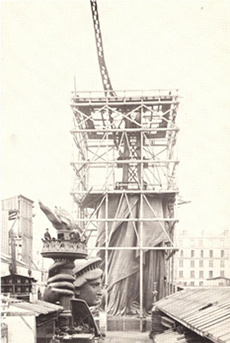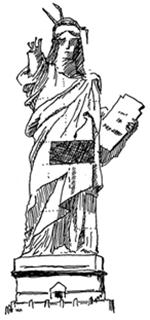InTrans / Jun 29, 2015
Why should I care: Statue of Liberty without construction workers?
Go! Magazine
 posted on June 29, 2015
posted on June 29, 2015
In the last article of this series “Why should I care: The Leaning Tower of Pisa with a civil engineer?”, we learned that engineers are vital to making things structurally sound. In this article, we are going to look at some of the lesser known facts about the Statue of Liberty. Think you know everything? Did you know that it was constructed twice?
Who do you know that is 305 feet tall with a shoe size of 879 feet long? Originally named “Liberty Enlightening the World,” the Statue of Liberty this year, in 2015, celebrates its 130th anniversary since initially landing in the United States (in June 1885). But why should you care? Well, she literally “stands for” the friendship between France and the United States as well as the abolition of slavery in the US.
But, did you know, although seemingly a worthy cause, there was great difficulty in leveraging funds to both build and place the statue?
High hopes for the Statue of Liberty
Two of the most well-known people involved in the Statue of Liberty’s construction include Frédéric Bartholdi and Gustave Eiffel (who also constructed the Eiffel Tower). Some argue that the architect, Bartholdi, originally wanted to construct the statue to give to Egypt instead of the United States. But after failing to strike a deal with Egypt, many sources claim that was when Bartholdi thought of giving it to the US.

The US had to raise about $2.5 million (in today’s dollars) to build the foundation/pedestal that the statue stands on. In total, the statue cost about $8 million to construct. After the complete construction of the Statue of Liberty in France, she was deconstructed and packed into 214 large crates to be shipped to the US. After traveling through an extreme 72 hour storm, which nearly capsized the ship and all the crates, they arrived on the coast of New York.
Now imagine that you spent several years of your life coming up with an idea, fundraising it, building it, and then, once it got to its destination, they weren’t ready for it! That is exactly what happened with the Statue of Liberty once it arrived in the US. In fact, the crates sat for over a year on Bedloe’s Island before Joseph Pulitzer and his newspaper, The World, did a national campaign to raise the money. After just a few months, enough money was raised through Pulitzer’s call to America for funds to build the pedestal.
Building the statue
Similar to how Mount Rushmore was constructed, the work began with reproducing a model that was just 36 feet tall. The actual Statue of Liberty, without the pedestal, stands a total of 151 feet tall! Broken into sections, the statue was constructed by measuring and multiplying the model by four. For each section, the construction workers had to take about 9,000 measurements! Using about 300 separate sheets of copper, which has a thickness of a little less than two pennies put together, sections were hammered by hand and then placed over Eiffel’s iron frame.

The reason why the Statue of Liberty is still standing today is due to that sturdy iron frame. Eiffel designed a 92 foot support as a pylon (i.e., a simple tower structure). He then attached flat metal bars to the outside to support the copper statue. This allowed for great flexibility and stability; in fact, when the wind blows 50 miles per hour, which happens a lot on Liberty Island, the crown of the statue can sway about three inches from side-to-side!
Once the statue made it to the US and was ready to be assembled, it was just a matter of putting the pieces together. The first step was reassembling Eiffel’s iron frame. Once that was in place, the rest of the statue was put together using steam driven cranes. To compare, it took the French three years to put the statue together, whereas the US (once the pedestal was funded and built) did it in a single year. In both the US and France, the statue required long hours of construction work to get it built in such a short time period.
What if construction workers hadn’t helped?
Since the Statue of Liberty’s groundbreaking in 1886, there has been two periods of restoration. One restoration period was in the 1920s following the “Black Tom” explosion in New Jersey during World War I. The second occasion was in the 1980s. This time the goal was to replace rusting original cast iron interior with stainless steel bars as well as replace the original torch. This required scaffolding on the outside of the statue so that workers could begin work on the interior over a period of four years (from 1982-1986) in order to be finished before the statue’s centennial celebration.

But what would the statue look like had there not been construction workers to help with the restoration process? Maybe her arm, or the torch, would have toppled over during high winds. Or what if when Hurricane Sandy hit in 2012, the statue completely fell over! Graphic designer, Stephen Post, brings these guesses to life in his “bad engineering” illustration of the Statue of Liberty.
Fun facts
So why is the Statue of Liberty green? Here’s a little chemistry refresher: Over a 30 year period the copper exterior oxidized due to water and air (namely oxygen) exposure that turned the statue the green color you see today. But that layer of green you see is actually a good thing, because it protects the inner layer from being corroded further.
Bartholdi originally wanted the Statue of Liberty to be covered with gold, but the finances were way too high. As it stands now, the copper that covers the statue is the equivalent of about 30 million pennies!
The Statue of Liberty was originally administered by the United States Lighthouse Board, but after failing to create an effective lighthouse from the Statue’s torch, it was turned over to the Department of War followed by the National Park Service, who still administers it today.
Related links
http://twistedsifter.com/2013/05/rare-photos-of-the-statue-of-liberty-under-construction/
http://whc.unesco.org/en/list/307
http://www.history.com/this-day-in-history/statue-of-liberty-arrives-in-new-york-harbor
http://www.libertyellisfoundation.org/statue-facts
http://whc.unesco.org/en/list/307
By Jackie Nester, Go! Staff Writer